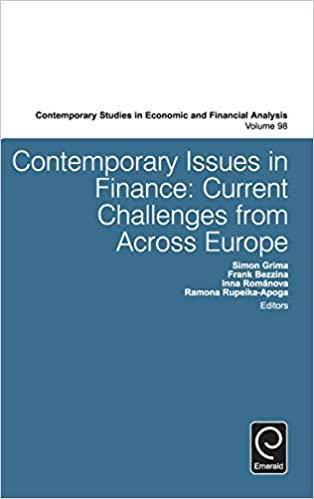Question
With a callable bond, the yield to maturity can often be misleading if it is likely that the bond will be called. In general, a
With a callable bond, the yield to maturity can often be misleading if it is likely that the bond will be called. In general, a bond will only be called when interest rates have fallen since the company issued the bond. In this case, the company will refund the bond if possible (and profitable) for the company. Refunding means that the company issues new bonds with a lower coupon rate and repurchases (calls) the outstanding bonds with a higher coupon rate. Suppose we have a bond that has a fixed call price and the following information:
Settlement date: 4/15/2017 Maturity date: 10/15/2031 Coupon rate: 9.00% Coupons per year: 2 Price (percent of par): 117.4 Redemption value (percent of par): 100 Call premium (percent of par): 7 Next call date: 10/15/2021
What is the YTM of this bond? Using the YIELD function, we find: Yield to maturity: ?
Notice that interest rates have apparently fallen since the bond was first issued. If the company calls the bond issue, an investor will not receive the cash flows until maturity, but will stop receiving cash flows when the bond is called. In this case, the yield to call (YTC) may be a more appropriate measure of the investor's return. To find the YTC, we used the call date as the maturity date. We must also remember to include the call premium as part of the redemption value since the investor will receive the par value, the call premium, and the last interest payment on the call date. So, the TYC for this bond is:
Yield to call: ?
In this case, if the bond is called, the bondholder will receive a lower return than if the bond is not called. For a bond with a make-whole call provision, if the bond is called, then we need to find the call price. Suppose we have the following bond information: Call date: 7/1/2017 Maturity date: 7/1/2026 Coupon rate: 7.50% Treasury rate at call: 5.20% Call rate premium over Treasuries: 0.20% Redemption value (percent of par): 100 Coupons per year: 2
We can use the PRICE function to find the call price of the bond. To do this, we will use the call date as the settlement date. So, the call price of the bond is: Call price: ?
Here are a couple of questions for you: What happens to the call price if the Treasury rate is higher? What if the call rate premium over the Treasury rate is higher?
Step by Step Solution
There are 3 Steps involved in it
Step: 1

Get Instant Access to Expert-Tailored Solutions
See step-by-step solutions with expert insights and AI powered tools for academic success
Step: 2

Step: 3

Ace Your Homework with AI
Get the answers you need in no time with our AI-driven, step-by-step assistance
Get Started


